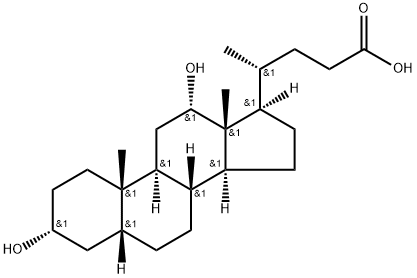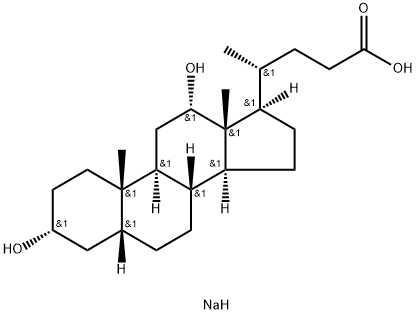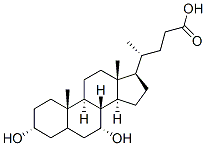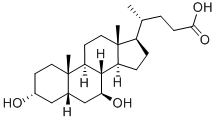Deoxycholic acid , 98% , 83-44-3
Synonym(s):
3α,12α-Dihydroxy-5β-cholanic acid;7-Deoxycholic acid;Deoxycholic acid;Desoxycholic acid
CAS NO.:83-44-3
Empirical Formula: C24H40O4
Molecular Weight: 392.58
MDL number: MFCD00003673
EINECS: 201-478-5
| Pack Size | Price | Stock | Quantity |
| 5g | RMB35.20 | In Stock |
|
| 25G | RMB155.20 | In Stock |
|
| 100G | RMB388.00 | In Stock |
|
| 500G | RMB1808.80 | In Stock |
|
| 2.5kg | RMB11199.20 | In Stock |
|
| others | Enquire |
PRODUCT Properties
| Melting point: | 171-174 °C(lit.) |
| Boiling point: | 437.26°C (rough estimate) |
| alpha | 55 º (c=1, EtOH) |
| Density | 0.9985 (rough estimate) |
| vapor pressure | 0.004Pa at 20℃ |
| refractive index | 1.4460 (estimate) |
| Flash point: | 9℃ |
| storage temp. | room temp |
| solubility | 0.24 g/L (15°C) |
| pka | 5.15(at 20℃) |
| form | Solid |
| color | White to Off-White |
| optical activity | [α]20/D +54±1°, c = 1% in ethanol |
| biological source | ox bile |
| Water Solubility | 0.24 g/L (15 ºC) |
| Merck | 14,2899 |
| BRN | 3219882 |
| Stability: | Stable. Combustible. Incompatible with strong oxidizing agents. |
| LogP | 5.34 at 22℃ and pH5.7 |
| Surface tension | 54mN/m at 51.3mg/L and 20℃ |
| CAS DataBase Reference | 83-44-3(CAS DataBase Reference) |
| EPA Substance Registry System | Cholan-24-oic acid, 3,12-dihydroxy-, (3.alpha.,5.beta.,12.alpha.)- (83-44-3) |
Description and Uses
Deoxycholic acid sodium salt, which is a secondary bile acid and the metabolite of intestinal bacteria, provides a nonsurgical treatment to significantly reduce submental fat in adults via injection directly into moderate-to-severe fatty tissue below the neck. When injected into fatty tissue, deoxycholic acid helps destroy fat cells. Although deoxycholic acid has many applications beyond human health, the application as a dyslipidemia drug was licensed to Kythera from Los Angeles Biomedical Institute at Harbor-UCLA Medical Center in 2007. Allergan acquired Kythera recently in 2015.
Deoxycholic acid has been used in a modified procedure to recover 40-80% of a protein from a 1 μg/mL solution. It forms complexes with fatty acid. Used as an emulsifying agent in food, a precursor in the synthesis of cortisone, and a gallbladder stimulant. It has been used to study assess how physiological concentrations of ursodeoxycholic acid (UDCA) vs. deoxycholic acid (DCA) affect barrier function in mouse intestinal tissue. Deoxycholic acid has been used in a study to assess a pH-Responsive Mechanism of a Deoxycholic Acid and Folate Co-Modified Chitosan Micelle under Cancerous Environment. It has also been used in a study to investigate dose-dependent anti-inflammatory effect of ursodeoxycholic acid in experimental colitis.
Safety
| Symbol(GHS) |  GHS07 |
| Signal word | Warning |
| Hazard statements | H302 |
| Precautionary statements | P301+P312+P330 |
| Hazard Codes | Xn |
| Risk Statements | 22-36/37/38-37-20/21/22 |
| Safety Statements | 26-36-37/39-22 |
| RIDADR | UN1230 - class 3 - PG 2 - Methanol, solution |
| WGK Germany | 3 |
| RTECS | FZ2100000 |
| TSCA | Yes |
| HS Code | 29181990 |
| Hazardous Substances Data | 83-44-3(Hazardous Substances Data) |
| Toxicity | LD50 oral in rat: 1gm/kg |




